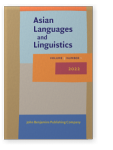Vol. 3:1 (2022) ► pp.60–88
Dimensional adjectives in Nuosu Yi
In this paper, we discuss two types of dimensional adjectives in Nuosu Yi (Tibeto-Burman), which we refer to as Positive adjectives (PAs) and Equative Adjectives (EAs). We show that PAs and EAs are subject to different distributions in gradation structures: EAs are only admissible in gradation structures that can be associated with measure phrases, which include differential comparatives (e.g., Ayi is 2 cm taller than Aguo.) and degree questions (e.g., How tall is Ayi?). PAs are licensed elsewhere, including comparatives that do not introduce a differential (e.g., Ayi is taller than Aguo.), the intensification construction (e.g., Ayi is very tall), the superlative construction (e.g., Ayi is the tallest), etc. Assuming that measure phrases are degree-denoting expressions, we propose that the complementary distribution of PAs and EAs in Nuosu Yi is due to their different semantics: PAs are context sensitive predicates that do not introduce a degree argument (of type <e, t>), while EAs are degree predicates (of type <d, <e, t>>).
Article outline
- 1.Introduction
- 2.Gradation structures in Nuosu Yi
- 2.1Gradation structures for PAs
- Comparatives (with no differentials)
- Equatives
- Exclamatives
- Intensification
- Excessives
- Superlatives
- 2.2Gradation structures for EAs
- Differential comparatives
- Degree questions (Exclamatives)
- Equatives (exactly as Adj. as)
- 2.3Summary
- 2.1Gradation structures for PAs
- 3.Two modes of comparison: Explicit vs implicit comparison
- 4.Analysis
- 4.1The degree-based approach and the delineation approach
- 4.2The semantics of PAs and EAs
- 5.Modifiers of PAs
- 6.A decompositional analysis of PAs and EAs
- 7.Cross-linguistic comparison and conclusion
- Notes
- Abbreviations
-
References
